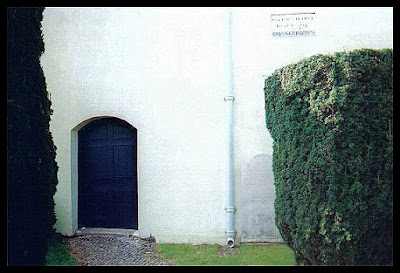Wednesday, 5 August 2020
Vintage Scrapyard, Devon
I absolutely loved this site! Having seen it several times whilst travelling past on the bus, I wasn't sure if it was live or abandoned, so I decided to make a visit in autumn 2007. As it happens, the yard turned out to be a working site but the owner kindly allowed me to have a wander around and he also told me some of its history.
I'm not sure if it's still there, or in a similar condition, but as it was a working yard containing a large amount of vehicles and equipment I've decided not to disclose its exact location. I've also taken the location off my website; a little late and I wish I'd have thought about it before. Considering that there's a lot more rural crime these days, and as I'm bringing it back into public view with this new article, it's better to be a bit more circumspect.
The land was once the site of a sawmill, built in 1895, and before that it was used as saw pits. The loading shed was built during the 1950's, when it became a scrapyard. Now it is mainly used for restoring vintage machinery.
There was so much to see, including several tractors and other rural machinery. Together with a sunny, Autumnal day, it was altogether very photogenic as well as interesting.
Not being very conversant with most of the machinery, I had some help from several members of the forum Derelict Places. Some of it was contradictory, so where appropriate I wrote both identifications.
I've been told that he little excavator, below, is a Whitlock, which was an early competitor of JCB, based on either a Ford or Massey Ferguson Agricultural tractor. They were popular as a very good budget machine.
The rather unusual tractor below has large spikes on the front and I was informed that it's used for heavy winching, such as pulling logs in forestry, the spikes lowered onto the earth in order to act as an anchor to give the tractor balance.
Amongst the various trucks and tractors there was also a delightful old steam engine, which the owner told me was made in 1911 for Peebles in Morcambe, Lancashire.
And parts of an old road roller - I've been told that the front roll is from a 1911 Aveling roller - together with a fab little cog or wheel.
Lots more wheels...
A Coles crane, below, in use during the 1960s and 70s.
And a couple of lorries.
I was told that the above truck is a Fordson Thames E4 GS 4x4 Gun Tractor from the 1950's. But then again, someone else told me that it was a BLSP (British Light Steel Pressings) cab; the firm owned by Rootes who also owned Commer. I wouldn't have a clue myself, so I'll leave it up to my readers to come to their own conclusions.
Above, some sort of motor, possibly an outboard motor to a boat on the top? Or maybe a tank from a motorbike? Forgive me if I'm incredibly wrong, lol!
And there we have it! An altogether fab morning out with so much to see and enjoy. And I hope you enjoyed this little foray too. :)
Saturday, 1 August 2020
Salem Chapel, East Budleigh, Devon
I came across this rather lovely chapel in 2008, whilst in a friends car on the way to Exmouth. Knowing nothing about it at the time, we stopped to investigate and take some photos. However, it also has a lot of history attached to it, spanning from Devon in England to a tentative connection with Salem in Massachusetts, USA.
A square building with a hipped roof; the plastered walls of the chapel and assembly room are thick enough to be cob on stone rubble footings. A lovely old and mellow red brick wall at the front includes square gate posts, 19th century cast iron gates and a delightful wrought iron overthrow with lamp holder, adorned with scrolls and twiddly bits - a technical word, that! ;)
The construction of the roof is unique, providing a massive attic. This was ideal for storing smuggled items, with the advantage of a hidden lookout from where any approaching Revenue Men could be seen.
This reminds me of Rudyard Kipling's poem A Smugglers Song, in which a parson is included in this refrain...
"Five and twenty ponies,
Trotting through the dark -
Brandy for the Parson, 'Baccy for the Clerk.
Laces for a lady; letters for a spy,
Watch the wall my darling while the Gentlemen go by! "
It wasn't open but I was able to take these two photos through the window.
The tiny churchyard is enclosed by a whitewashed rubble and brick wall.
And the tenuous connection with Salem, Massachusetts? Salem was first settled by Europeans in 1626, led by Roger Connant. Although this was before Salem Chapel was built, the name Salem was a shortened version of Jerusalem and was popularly used as chapel and place names, and Roger Connant himself was born in East Budleigh.
The adjacent assembly room, below.
The front of the assembly room comprises two early 19th century sash windows containing thirty panes. These are either side of a later four panelled door. As seen below, the end of the assembly building contains a wide doorway which leads to a basement.
Subscribe to:
Comments (Atom)



















































